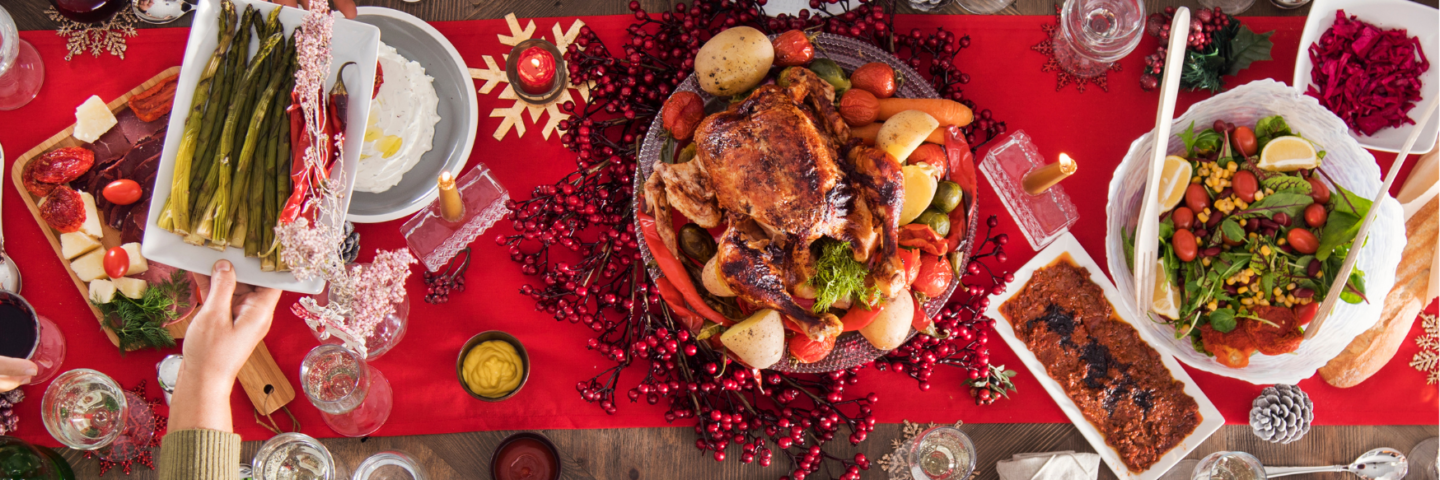From Nick Adams MW
Pescatarians
Easy to forget that many fish and shellfish are in plentiful supply (and at their best) in the winter with the following particularly good and sustainable examples:
- Sea Bass Farmed Sea Trout
- Brill
- Turbot
- Lemon Sole
- Plaice
- Gilt Head Bream
- Hake
- Monkfish
- Mackerel
- Mussels
- Oysters
- Crab
- Scallops
- Clams
- + as ever – salmon and smoked salmon!
- And there is always an option to do salmon wrapped in pastry
- Also look out for recipes to cure your own salmon – the beetroot and tarragon option looks and tastes spectacular for example
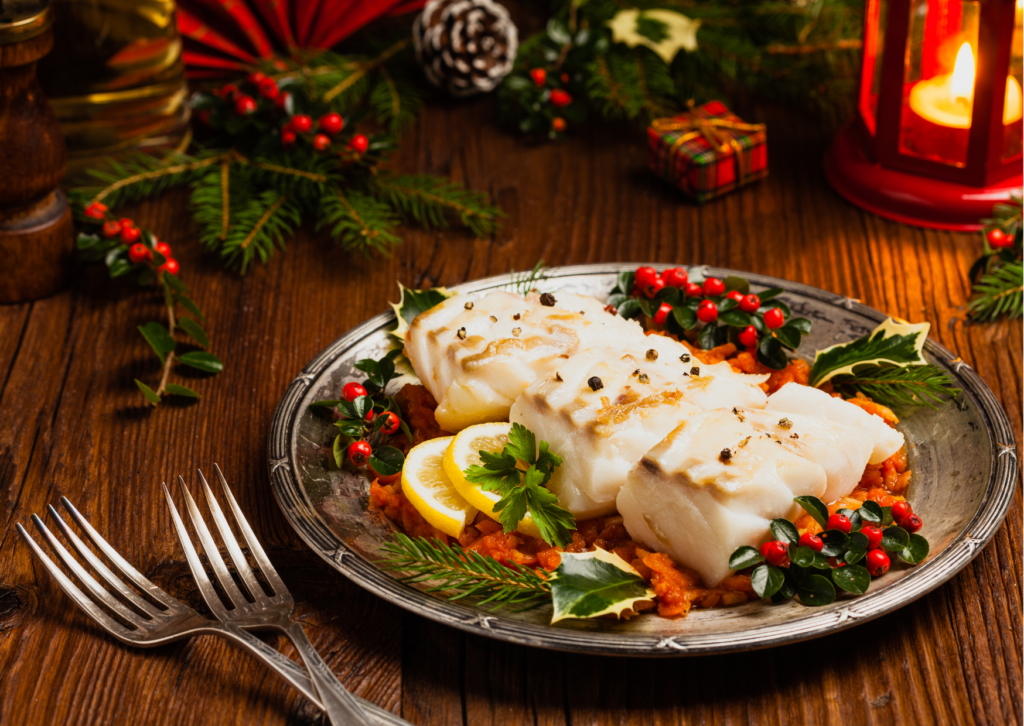
I think the recommendations are quite straight forward – mainly white wines and unoaked and crisp for plainly cooked fish; but richer, and oaked Chardonnay based wines (as a substitute to list below) with fish with butter-based sauce (beurre blanc/noir, hollandaise). The other element is to consider Rosé wine with oilier fish as an option – again dry and crisp. However, if you like red wine with fish no one is stopping you, but I would recommend looking at lighter bodied and lower tannin reds if so.
- Crowd Pleaser: Pinot Grigio Ponte del Diavolo Grave Friuli, Italy – crisp, unoaked, authentic apple and pears with a lovely touch of spice
- Try Something Different: Amalaya Torrontés | Riesling Salta, Chile – zesty, clean unoaked with an exotic perfume and a citrus fruit kick, or …. Rosé
- Rosa dei Frati Cà dei Frati Lombardy, Italy – a dry and fuller bodied rosé with bold red fruit and berry notes and a creamy texture (good wine to go with the beetroot cured salmon)
- Treat: M3 Chardonnay Shaw & Smith Adelaide Hills, Australia – the balance between delicacy and richness is amazing here and the lacy oak is so well integrated that you hardly notice it. Pristine stone fruits and a fuller bodied but not remotely heavy style. Perfect match with richer fish dishes and those with a butter-based sauce.
Vegetarian
I think vegetarian dishes allow for a broad cavass of wines to choose from – including sparkling – hence the longer note. In general, though, it is harder to match dry and big, tannic red wines – they tend to sit aside a bit from many vegetarian dishes. If you enjoy these wines I would suggest going for bolder flavoured dishes and maybe char grilled or roasted when cooking – and for non-vegans top and grill some cheese as well.
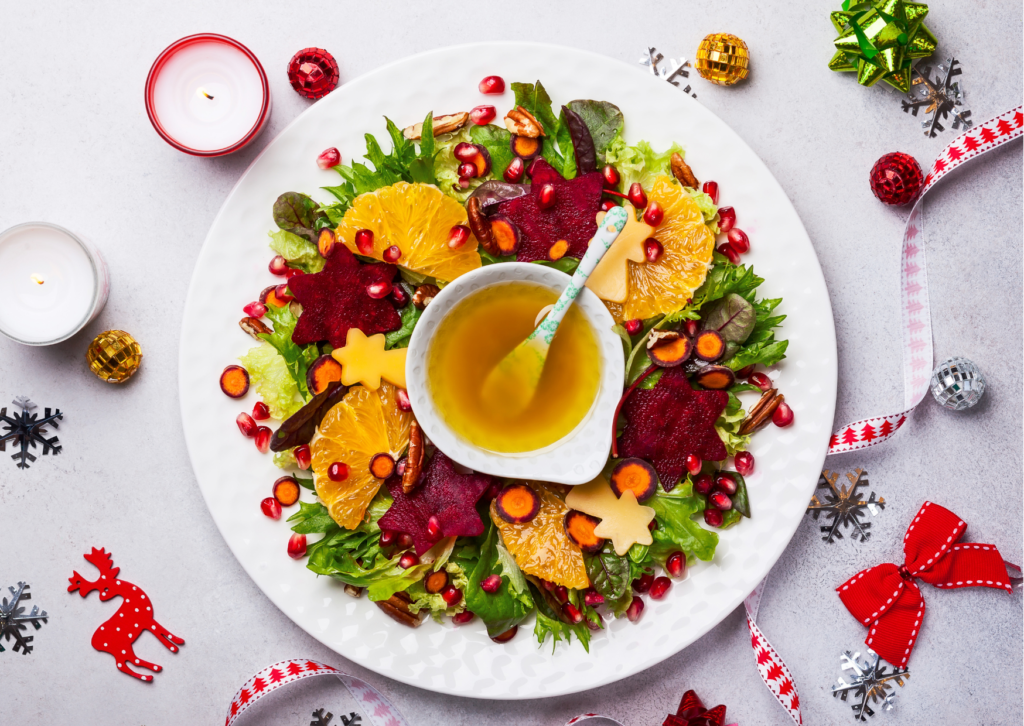
I often think the key to matching is … does it include tomato in the recipe. If so, the naturally high acid in tomatoes requires a high acid wine to compliment – which could be red as well as white. For example, a homemade pizza, with a rich tomato base – and maybe roasted vegetable – could work well with an Italian red – if not too tannic; the same principle also applies with a good ratatouille.
If you like some spice – such as a vegetable curry or samosa for example – then a lightly oaked white can also work, along with spicier white grapes such as Gewürztraminer, Pinot Grigio, Grüner Veltliner.
If you char grill vegetables as mentioned above (winter root vegetables are a delight at this time of year) then you can be bolder with the wine – due to their “toasty” character – to include rosés for example as well as reds. A lot also depends on if you are using pastry and/or eggs (not relevant for Vegans I appreciate) – eg making a tart – as this means you can serve a richer and fuller bodied white – such as a gently oaked Chardonnay. This is especially so if you have a gratin (cheese) element such as with an onion and cheese flan. The stronger the cheese element the bolder the wine choice can be.
Asparagus is a good option too and works well with most Sauvignon Blancs for example – including if done classically with Hollandaise sauce. Another variety which compliments asparagus is Viognier.
One of my favourite dishes is risotto with wild mushrooms and a vegetable stock (with Parmesan/Parmignano shavings for non vegans). This works very well with Pinot Noirs – whether Europe or the New World
With salads (and crudités) a lot depends on the intensity of the leaves and vegetables, plus the dressing combination. At the blander end of the scale, for example, is iceberg lettuce, maybe at the other endives such as radicchio, or frissé. Then there is onion – the minute this enters the fray the whole salad “warms” up. Add watercress, or rocket, and the peppery levels increases; just a few coriander leaves add citric notes. I think it very difficult to be at all definitive here other than to say that white wines invariably work better – and again unoaked. You can also consider Sparkling Wine.
Nothing beats a mixed plate of blanched, crunchy vegetables – crudités – and I think especially when served with Mayonnaise, or even better Aioli! If you use these richer sauce accompaniments, then you can indulge in more medium bodied and even lightly oaked white wines. Otherwise for vegans go for a bold flavoured salad dressing.
A final note on the ever-popular beetroot. With its firm earthy notes and fleshy texture, it is difficult, but not impossible! Lighter Grenache based reds and rosés from the south of France work well here.
For cheese (non vegans) and desserts please see later sections. Please find some good “all-rounder” selections below – all wines are suitable for vegan and vegetarians.
- White – Soave Classico Montegrande Cantina di Monteforte, Veneto, Italy – clean, vibrant with fine notes of stone fruits and chamomile, with a lick of oak. This will match with many vegetable dishes and salads
- Rosé – Monastrell Rosado Bodegas Familia Castaño, Valencia, Spain – a finely textured supple rosé with bright red fruits and a herbal touch. Will work well with bolder flavoured dishes and roasted/char grilled vegetables, including tomato, also beetroot
- Red – Lionheart Barossa Valley Shiraz Dandelion Vineyards, South Australia – smooth and rich but not heavy with silky tannins and bright blackberry fruit and peppery spice – perfect with anything with spice or grilling elements, as well as richer flavoured vegetable such as aubergine, roasted peppers, pan fried onion, olives etc.
Soup
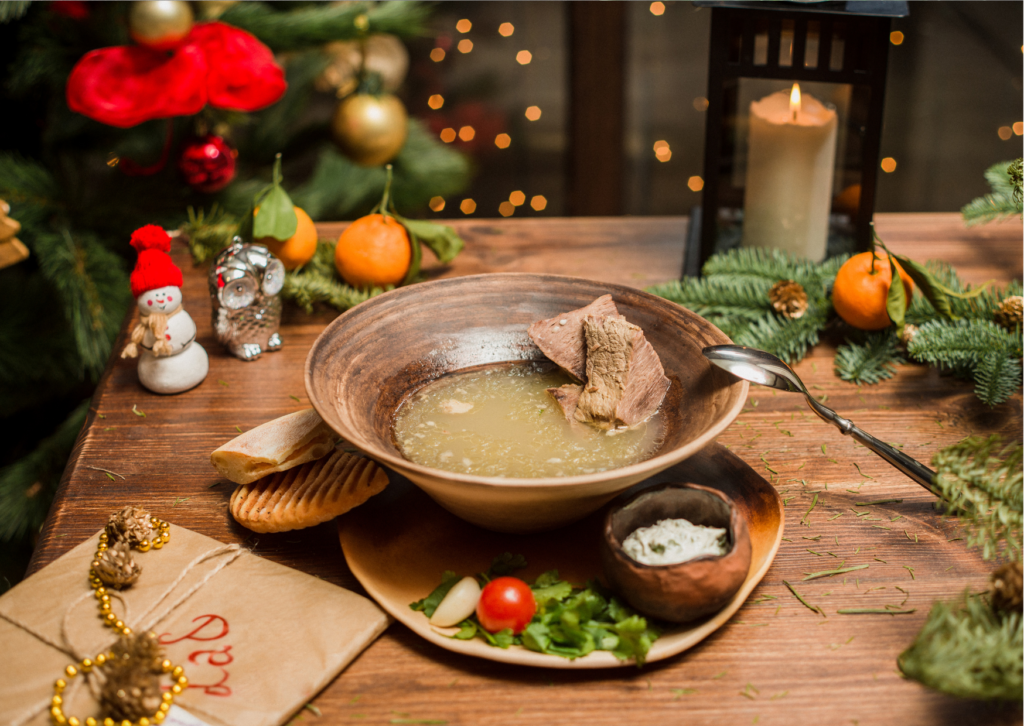
Tis the season for soup – for sure. One of my favourites, and this is my homemade recommendation for the holidays – nothing beats a great pan of vegetable soup – onion, leek, celery, carrot, black cabbage (cavolo nero is just so good in soups) garlic, borlotti beans, flat leaf parsley with pressed tomato and deseeded chopped pulp. And what makes this so flexible is you use two pans – in one add chicken stock and shredded ham hock for the carnivores; and in the other, skip the ham and use vegetable stock for the veggies – then everyone is happy! And to finish it off use any leftover bread to make your own crostini (roast in the oven with a little olive oil) topped with cheese and re bake – either a good cheddar, or gruyere, or hunt out the amazing smoked Lincolnshire Poacher. Or indulge in shaved truffle on the top.
Or, with your left-over game and chicken bones, roasts these and use as the basis for a game soup –just perfect when you come back from that Christmas or Boxing Day walk.
But to finish the whole experience off – and please trust me – chill down a bottle of Fino sherry – the Inocente from Valdespino in the dinky ½ bottle. This match is also made in heaven if you want to indulge in a shellfish bisque style soup (as per the photo above left). But I do understand when people say they don’t like liquid with liquid, but I would encourage you to give it a go. The nuttier, dry Lustau Pata de Gallina Oloroso version also works well with vegetable soup (above right). So, the below is all about “Try Something Different”. If you don’t like sherry, then go with your favourite style of wine – soup is incredibly flexible.
- Try Something Different – Fino Innocente Valdespino (served chilled) – dry, crisp, bready, notes of green olive.
- Or Dry Oloroso Pata De Gallina Lustau Sherry (served “cool”) – dry nutty and savoury
Cheese
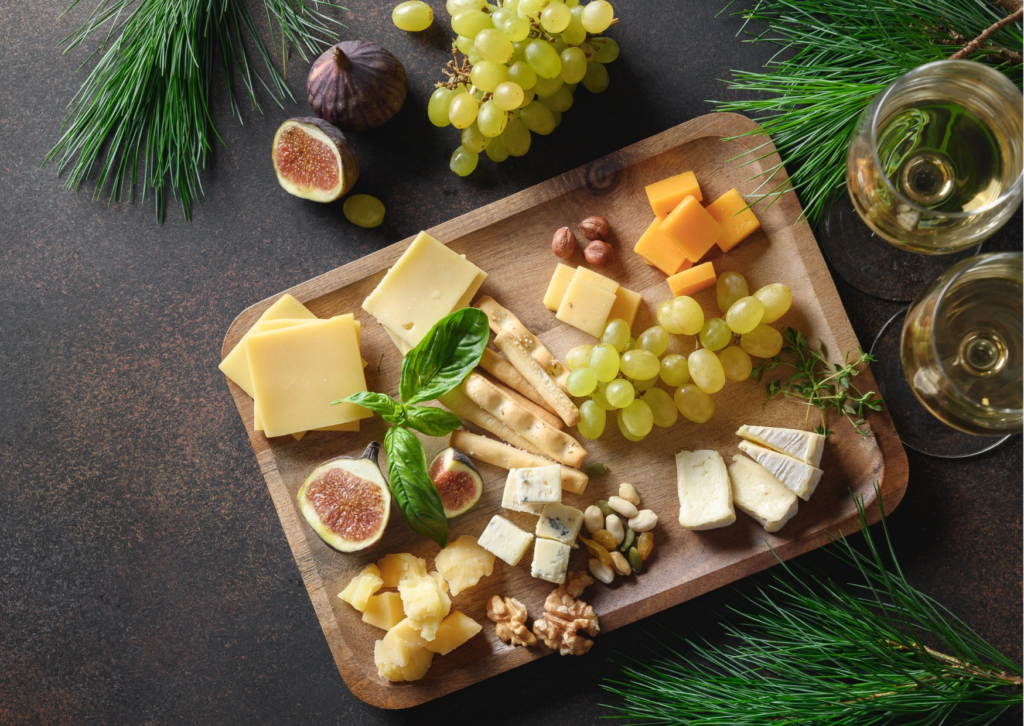
Another must have for Christmas. And is there anything more appealing than a great board of cheese on Christmas or Boxing Days? Sadly, the great Turkish fig season is over by then to go with them but look out for Fenland winter (white) celery – a classic savoury accompaniment – and some good grapes (I love the “Muscat” flavoured Sable grapes). Also, quince paste, or crab apple jelly is a fine partner.
The paradox with cheese is that for all its dairy richness the very product is itself very acidic, as souring the milk to start the whole process of production is essential to allow the milk to coagulate. Do not be deceived by the more-ish richness – there lurks behind an acid grip! Therefore, a high acid, tannic red wine is maybe what you don’t need to accompany it. You may be pleasantly surprised that a fuller bodied weightier white wine works rather well – especially with nutty cheeses like Comté, or a mature cheddar.
Otherwise, trusted old favourites such as Port and fuller bodied sweet wines work well with almost all types of cheese. I happen to live not that far away from the superb Stilton dairy of Colston Bassett – my own personal favourite for this cheese. They nearly always say when you buy directly from the dairy – and to quite them “this cheese has been made and matured at the dairy and is ready to be enjoyed right now” – and please do not pour port into it – drink it with it – they would all curdle at the dairy at the prospect of this direct blending! Also, beware, older cheese tends to produce ammonia – this is especially so with blue and soft cheeses – you can just smell its acrid notes in an instance, and it is a complete killer for any wine.
Letting a good Brie or Camembert run like Sir Mo Farah is not a good combination with any wine, however much you might like that style of cheese! In that case eat it on its own. Also, there is Roquefort, which is aged in salt, so beware no territory for any red wine, but wonderful with sweet whites. Here ended the lesson!
Please remember these wines go a long way and you can continue to enjoy them over the whole holiday season – they also make a fine after dinner drink by the fire.
- Crowd Pleaser – sweet, rich, and plummy (please serve cooled down): Fonseca 10 year old Tawny Port, Douro, Portugal
- Try Something Different – very sweet, caramel, “rum’n’raisins” (please serve very well chilled): Chambers Rosewood Vineyard Liqueur Muscat Rutherglen, Australia
- Treat – sweet, full bodied, cherry liqueur, liquorice (please serve at room temperature): Taylor’s Quinta de Vargellas 2002 Vintage Port, Douro Portugal (NB this wine needs to be decanted – you can do this the day before by the way and will keep in the decanter comfortably for another week to enjoy over Christmas and the New Year)
Christmas Pudding & Desserts
The key principle to matching sweet wines with desserts is to make sure the wine is at least as sweet as the pudding; else it tastes weak and rather thin (and paradoxically dry).
The first consideration is probably what goes with the Christmas Pudding (and Christmas cake and mince pies)? The wine can be quite sweet and as rich as you might want – such as a Chambers Rutherglen Liqueur Muscat (as mentioned in the cheese section), or a rich Pedro Ximénez Lustau’s San Emilio from Spain – these two will be splendidly hedonistic with the richness of the pudding, mince pies, also Christmas cake.
Then you have sweet but more delicate items such as meringue, fruit pies which would be swamped by these sort of dessert wines. Here a more refined sweet wine such as Sauternes or Tokaji Aszú from Hungary works just as well. Likewise, these same wines also team up with caramelised desserts (classically Tarte Tatin).
The biggest challenge comes with chocolate dishes – chocolate (especially high cocoa content) really challenges a lot of sweet wines – again they need to be sweet but also savoury, maybe even caramelised themselves in nature. An aged Tawny Port is a good partner for example (as mentioned in the cheese section) – but I have highlighted my first choice below for any chocolate dish you may be planning.
Apart from Late Bottled and Vintage Ports, all sweet wines should be served well chilled – this is very important to maintain balance and keep them from tasting heavy and cloying. And the good news is sweet wines go a long way – they can be sipped, savoured, and stoppered and returned to the fridge where they can last happily for up to a week, or longer in some cases. A little goes a long way! They can therefore be deceptively good value for money.
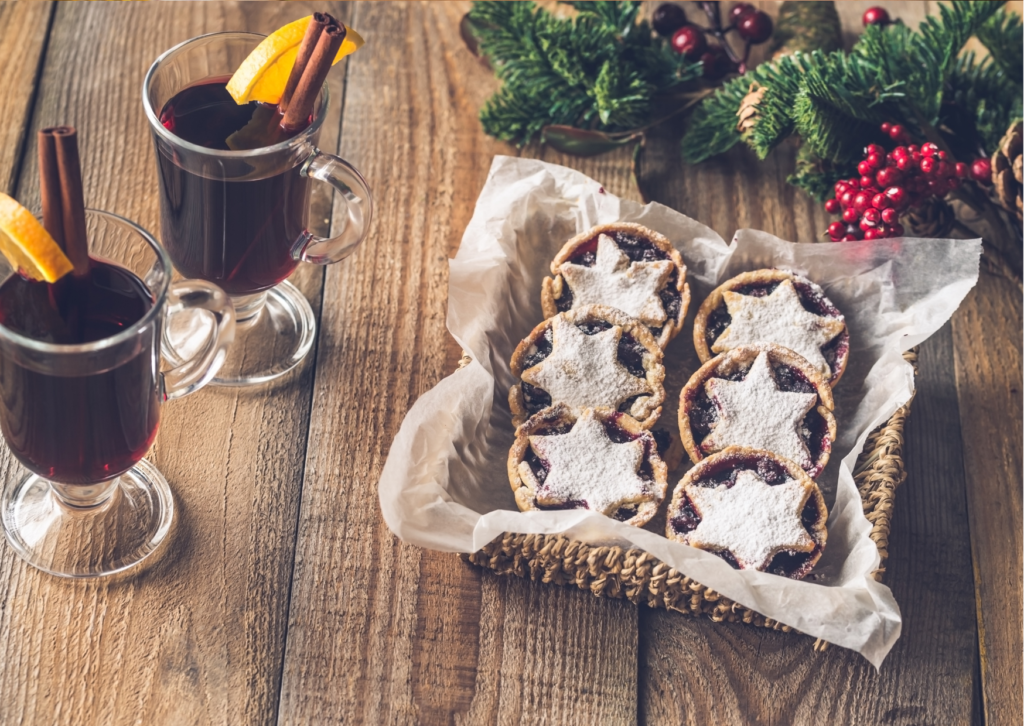
I have approached this section differently and highlighted several options for you with notes – I hope this helps you make the right selection.
First up a “Crowd Pleaser” and lovely easy drinking style. Made by Californian dessert wine specialist Andrew Quady this is a very fruity citrus styled dessert wine which is not too sweet (so avoid with Christmas Pudding and mince pies for example) but which will work with many fruit based puddings
Next up are two suggestions which should work perfectly with any caramelised desserts classically tarte tatin style, but also meringue based puddings and lighter cakes and pastries. Sweeter than the Quady both have notes of stone fruit (especially the Sauternes) and citrus (especially the Cordon Cut) but also great refreshment and vitality. Nice notes of honey and citrus peel too.
- Château Laville Sauternes Bordeaux, France – A classic from Bordeaux made predominantly from desiccated Sémillon grapes and oak aged.
- Mount Horrock’s Cordon Cut Riesling Calre Valley, South Australia – A “Try Something Different” wine – remarkably elegant and made from desiccated Riesling grapes in Clare Valley South Australia.
The next wine, for me, is perfect with anything chocolate and not as “heady” as Tawny Port. It has the sweetness, but also creaminess and savoury element which matches incredibly well with fine cocoa base desserts – or just chocolate on its own.
A speciality red dessert Roussillon wine style from France’s deep south and made mainly from late harvested Grenache grapes. The wine is lightly fortified and not too sweet and very more-ish. Great after dinner style too.
And finally, under the banner of “Treat Yourself” and “Try Something Different” there is the legendary luxurious late harvest, barrel fermented and aged Muscat from Klein Constantia in South Africa and the very traditional, vinous liquid caramel, dried grape belter from Domaine Argyros on the Greek island of Santorini.
The Vin de Constance would work well with all caramelised sugar (tatin) desserts and meringue, whilst the Vin Santó Argyros is a lovely substitute indeed to go with your Christmas pudding – less “heady” than say the Liqueur Muscat.

I hope this guide is useful – and covers as many options as possible for your plans and preferences over the coming holiday season. It is only a guide I must stress and eventually you must enjoy the sort of wines which appeal to you personally and – very importantly – within your budget. Above all, it is about sharing time and experiences and I think wine is part of that pleasure at this time of the year. And wine makes for a lovely Christmas present.
Have a very happy Christmas and New Year. Thank you for your support to Wine Trust in 2021 and I hope you have enjoyed the blogs along the way.
Nick Adams MW

